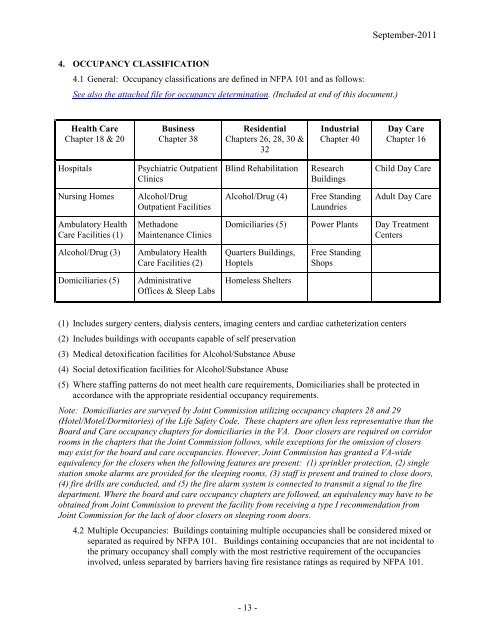Fire Protection Design Manual - Office of Construction and Facilities ...
Fire Protection Design Manual - Office of Construction and Facilities ...
Fire Protection Design Manual - Office of Construction and Facilities ...
You also want an ePaper? Increase the reach of your titles
YUMPU automatically turns print PDFs into web optimized ePapers that Google loves.
4. OCCUPANCY CLASSIFICATION<br />
4.1 General: Occupancy classifications are defined in NFPA 101 <strong>and</strong> as follows:<br />
See also the attached file for occupancy determination. (Included at end <strong>of</strong> this document.)<br />
Health Care<br />
Chapter 18 & 20<br />
Business<br />
Chapter 38<br />
Hospitals Psychiatric Outpatient<br />
Clinics<br />
Nursing Homes Alcohol/Drug<br />
Outpatient <strong>Facilities</strong><br />
Ambulatory Health<br />
Care <strong>Facilities</strong> (1)<br />
Methadone<br />
Maintenance Clinics<br />
Alcohol/Drug (3) Ambulatory Health<br />
Care <strong>Facilities</strong> (2)<br />
Domiciliaries (5) Administrative<br />
<strong>Office</strong>s & Sleep Labs<br />
Residential<br />
Chapters 26, 28, 30 &<br />
32<br />
Industrial<br />
Chapter 40<br />
Blind Rehabilitation Research<br />
Buildings<br />
Alcohol/Drug (4) Free St<strong>and</strong>ing<br />
Laundries<br />
September-2011<br />
Day Care<br />
Chapter 16<br />
Child Day Care<br />
Adult Day Care<br />
Domiciliaries (5) Power Plants Day Treatment<br />
Centers<br />
Quarters Buildings,<br />
Hoptels<br />
Homeless Shelters<br />
Free St<strong>and</strong>ing<br />
Shops<br />
(1) Includes surgery centers, dialysis centers, imaging centers <strong>and</strong> cardiac catheterization centers<br />
(2) Includes buildings with occupants capable <strong>of</strong> self preservation<br />
(3) Medical detoxification facilities for Alcohol/Substance Abuse<br />
(4) Social detoxification facilities for Alcohol/Substance Abuse<br />
(5) Where staffing patterns do not meet health care requirements, Domiciliaries shall be protected in<br />
accordance with the appropriate residential occupancy requirements.<br />
Note: Domiciliaries are surveyed by Joint Commission utilizing occupancy chapters 28 <strong>and</strong> 29<br />
(Hotel/Motel/Dormitories) <strong>of</strong> the Life Safety Code. These chapters are <strong>of</strong>ten less representative than the<br />
Board <strong>and</strong> Care occupancy chapters for domiciliaries in the VA. Door closers are required on corridor<br />
rooms in the chapters that the Joint Commission follows, while exceptions for the omission <strong>of</strong> closers<br />
may exist for the board <strong>and</strong> care occupancies. However, Joint Commission has granted a VA-wide<br />
equivalency for the closers when the following features are present: (1) sprinkler protection, (2) single<br />
station smoke alarms are provided for the sleeping rooms, (3) staff is present <strong>and</strong> trained to close doors,<br />
(4) fire drills are conducted, <strong>and</strong> (5) the fire alarm system is connected to transmit a signal to the fire<br />
department. Where the board <strong>and</strong> care occupancy chapters are followed, an equivalency may have to be<br />
obtained from Joint Commission to prevent the facility from receiving a type I recommendation from<br />
Joint Commission for the lack <strong>of</strong> door closers on sleeping room doors.<br />
4.2 Multiple Occupancies: Buildings containing multiple occupancies shall be considered mixed or<br />
separated as required by NFPA 101. Buildings containing occupancies that are not incidental to<br />
the primary occupancy shall comply with the most restrictive requirement <strong>of</strong> the occupancies<br />
involved, unless separated by barriers having fire resistance ratings as required by NFPA 101.<br />
- 13

















